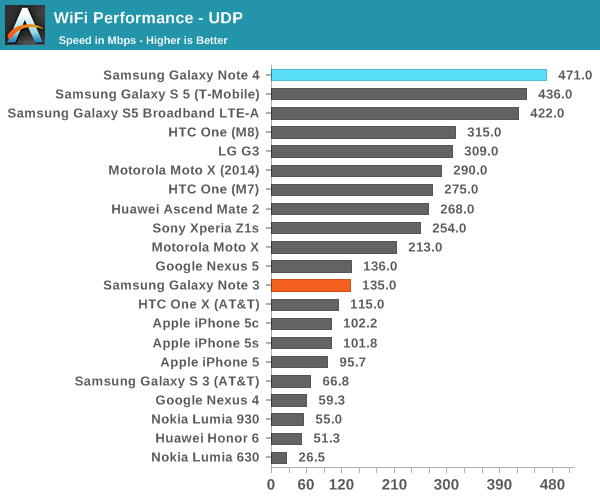The Samsung Galaxy Note 4 Review
by Joshua Ho on October 15, 2014 9:00 AM EST- Posted in
- Smartphones
- Samsung
- Android
- Mobile
- Galaxy Note 4
WiFi Performance
While the Galaxy S5 LTE-A Broadband had a Qualcomm Atheros solution (QCA6174), the Note 4 moves back to Broadcom's WiFi solution. In this case, we see the BCM4358, which is a revision of the BCM4354 that was first seen with Samsung's Galaxy S5. This shouldn't have any major differences outside of improved Bluetooth coexistence but antenna design can and does change between revisions. In order to test this, we use iperf and Asus' RT-AC68U router to try and achieve maximum performance.

As one can see, the Galaxy Note 4 has a strong showing in this test, easily surpassing every other device we have available for testing.
GNSS
At this point, it really goes without saying that the GNSS solution of choice is the one built into Qualcomm's modem. This allows for fixes based upon initial location and time data that the modem has, and therefore in practice every GPS fix is a hot fix and takes around 5 seconds for a lock in good conditions. In the case of the Note 4, with airplane mode on and no assistance data I saw that it took around 50 seconds to achieve a lock, but this is strongly dependent upon environmental conditions. Once locked, I found that the Note 4 had quite a strong lock and quickly went down to 10 foot accuracy level without issue.
Misc
Similar to the new Moto X we see a Cypress CapSense solution in the Note 4 but this is likely used for the capacitive buttons rather than any impedance-matching antenna tuner. The UV sensor appears to be a Maxim design win, although there's no information on the specific part. The battery's fuel gauge is also a Maxim part, as is the speaker amplifier and pulse sensor. The NFC chip used is NXP's PN547, so host card emulation should be supported and therefore Google Wallet's tap and pay system should work as well.











195 Comments
View All Comments
akdj - Thursday, October 30, 2014 - link
Sorry. Something was lost in translation there;)I'm not going to go tbrough the dozen+ grammatical and punctuation errors, but my point was to compare iOS to Android with their siblings ...the Chromebook and OS X. Windows has the same if they're able to finally figure phones out! The SPIII is a HELLUVA design and enough difference between itself and the iPad (including the price, you're looking more like comparing a nice 13" rMBP w/Haswell ans Iris Pro graphics;))
Vertical and horizontal support. iOS and OS X with continuity and handoff being another extension of Airdrop is absolutely incredible!
The new near 15million pixel 5K iMac is a Grand Slam
iPad Air 2, it's A8X, a 2 and a ½ gen old 64 bit design---2GB of RAM, & a buck 28 built in with a half million 'optomized' tablet apps for everything from photo and video manipulation with Adobe, MS, & OS X integrated and aggregated alls to music creation, mixing and mastering ...magazines that are mind blowing, killer browser choices and unbelievably powerful video editing suites, drawing and sketching programs...old 'Chilton' fix 'em up guides or ForeFlight to file your F/P n tell ya how much gas you should pump in, while it considers diversions and real time weather and traffic. TCAS ans ADSB ...Jep charts, plates and updates in 'now' time, THAT'S a 'Tool!'
Farting around with ROMS is like rewiring your microwave. Why? It's to cook, melt, boil, or pop your F'ung popcorn!
tipoo - Wednesday, October 15, 2014 - link
Indeed. I'm excited for Nvidias Denver CPU cores, finally someone else going with two big cores rather than four small.mpokwsths - Wednesday, October 15, 2014 - link
Something is not right here..."Around 450 nits" with auto brightness on???
Displaymate strongly disagrees with Anandtech. They measured "478 - 750 cd/m2" with auto brightness (1 nit = 1 cd/m2)
http://www.displaymate.com/Galaxy_Note4_ShootOut_1...
melgross - Wednesday, October 15, 2014 - link
There is variability in production. The differences you are seeing are well within that variability.mpokwsths - Wednesday, October 15, 2014 - link
Don't be ridiculous, please...Displaymate: "When Automatic Brightness is turned On, the Galaxy Note 4 reaches an impressive 750 cd/m2 in High Ambient Light, where high Brightness is really needed – it is the brightest mobile display that we have ever tested"
It is an out-of-space claim that there can be a variability in production of a 70% level...
tralalalalalala40 - Saturday, October 18, 2014 - link
hopefully the display doesn't keep that brightness very long. those pentile pixels will burn out. you'll have to use a screen saver.theduckofdeath - Thursday, October 16, 2014 - link
Sounds like a poor excuse for inaccurate testing to me. If the error margin was that huge, the display would be horrible to look at.JoshHo - Wednesday, October 15, 2014 - link
In practice I find that the 100% APL value is more representative of the perceived brightness, this is due to a difference in testing methodology.Pissedoffyouth - Wednesday, October 15, 2014 - link
I just bought a note 3, and I'm more than happy with it with a zerolemon 10000mah battery. This doesn't really offer much more really, more of an slight upgrade.I'd be interested to see why they didn't up the battery a little more considering they made the chassis bigger...
darkich - Wednesday, October 15, 2014 - link
I find it impossible not to notice the Apple reality distortion effect in this article.But nice try hiding it, AT.
I'll just state a fact proven by pretty much every other review - battery endurance on this device is clearly better than that on the iPhone 6+.